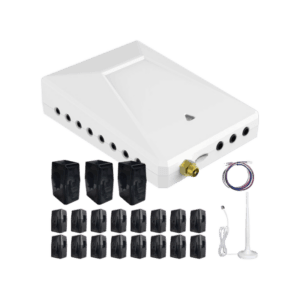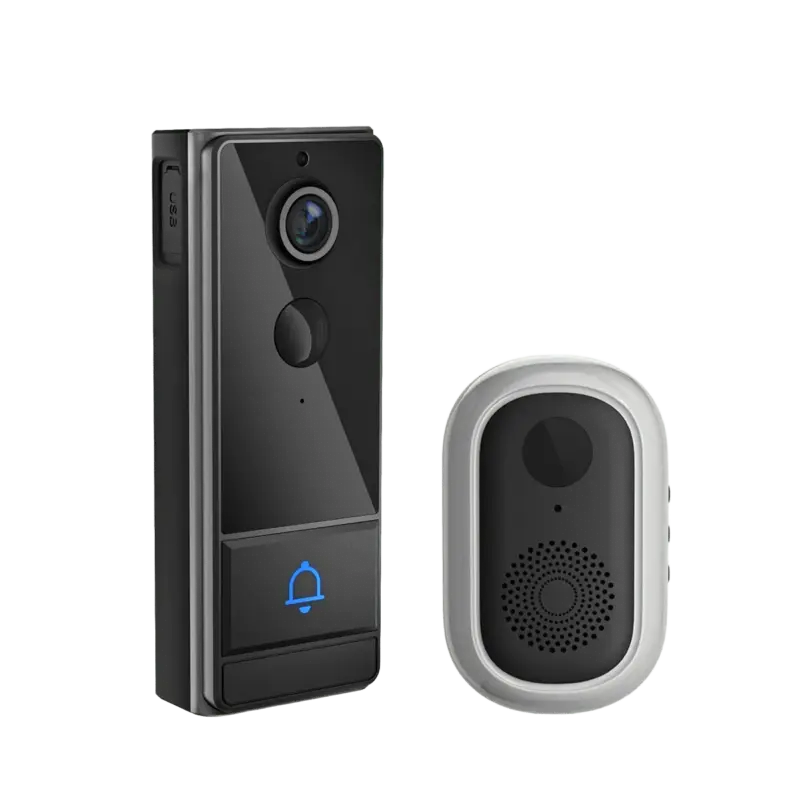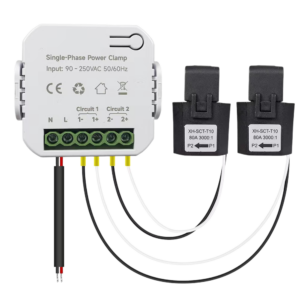Why Upgrading Your Home Electrical Panel Matters
In today's smart and technology-driven homes, upgrading your electrical panel is no longer a luxury—it's becoming essential. As homeowners increasingly adopt modern devices like smart thermostats, electric vehicles, solar panels, and home energy monitors, the traditional electrical panel might struggle to keep up. An outdated panel not only hinders energy efficiency but could also pose significant safety risks.
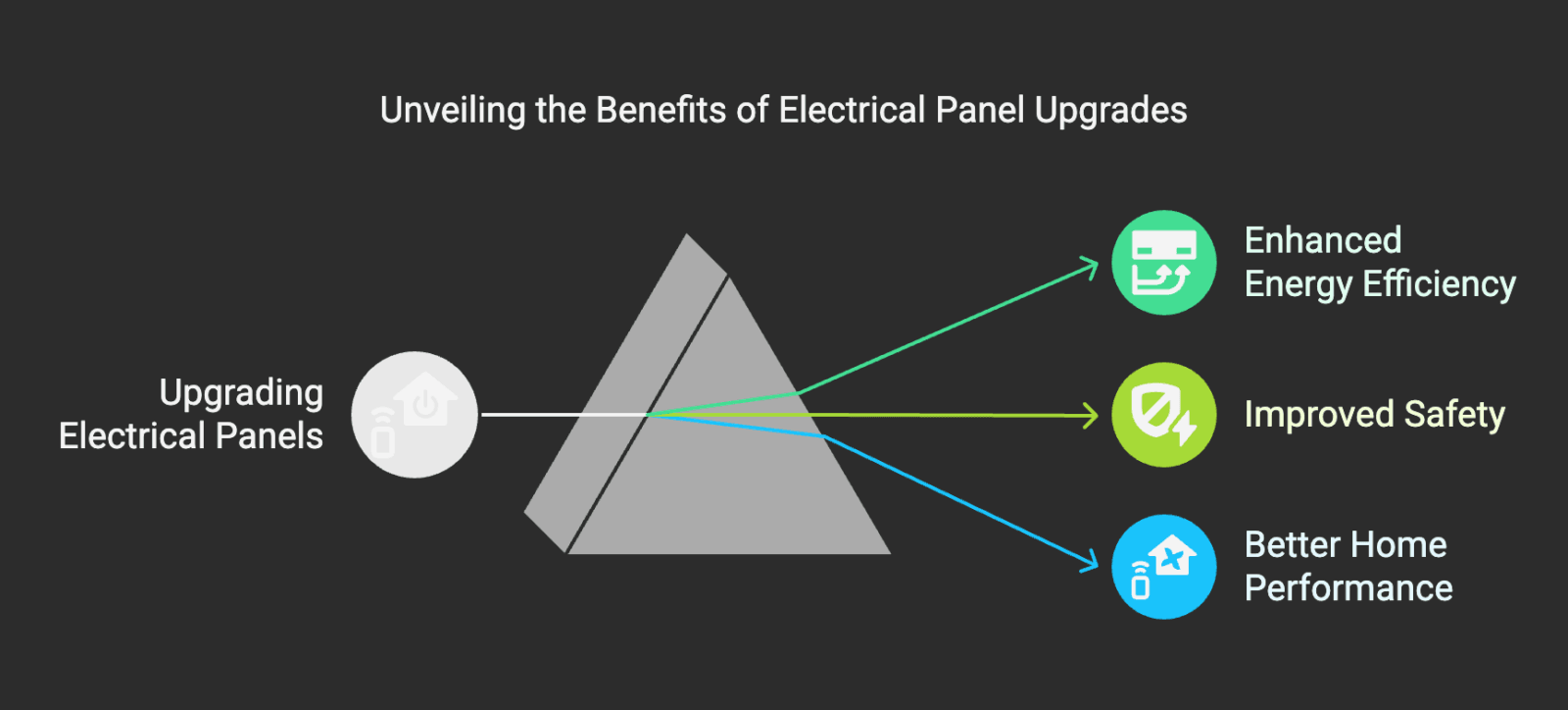
Picture this: you recently installed a state-of-the-art solar array, integrated an electric vehicle (EV) charging station, and upgraded your home's heating system with a sophisticated smart heat pump thermostat. However, your home’s electrical panel, originally designed decades ago, struggles to manage these modern demands. This mismatch can cause frequent breaker trips, power outages, and even potential electrical fires. Unfortunately, many homeowners overlook this critical component until serious issues arise.
Given that most homes in the United States utilize split-phase power (120/240V), understanding your electrical system and how an upgraded panel could dramatically enhance energy efficiency and safety is critical. As electricity usage patterns shift dramatically—driven by increased appliance consumption, electric vehicle adoption, and renewable energy integration—the electrical infrastructure must evolve accordingly.
In this comprehensive guide, we’ll explore the importance of upgrading your electrical panel, the technical considerations involved, and practical steps you can take. We'll discuss why modernizing your electrical infrastructure is a smart investment, detailing how it improves your home’s energy efficiency, safety, and overall performance.
Understanding Your Home’s Electrical Panel
An electrical panel, also known as a breaker box or load center, acts as the central distribution hub for electricity throughout your home. It divides power into circuits, each protected by circuit breakers or fuses, to prevent overloads and potential electrical fires.
While older homes were typically equipped with fuse boxes rated for lower amperages—often as low as 60 amps—most modern homes now require panels rated at least 100 to 200 amps. This increased capacity reflects the dramatic rise in electrical appliances, HVAC systems, EV chargers, and other high-powered devices.
What Phase is Normal American Home Power?
Most American households operate on what is known as split-phase power, commonly referred to as single-phase power. This configuration consists of two 120-volt wires and one neutral wire, providing both 120V for smaller appliances and 240V for larger loads like ovens, dryers, and air conditioners.
Here's how typical split-phase power distribution looks:
graph TD A["Utility Company"] -->|240V Split-Phase| B["Home Electrical Panel"] B -->|120V| C["Lighting & Small Appliances"] B -->|240V| D["Major Appliances (HVAC, EV Charger, Oven)"]
Signs Your Electrical Panel Needs an Upgrade
Recognizing the signs that your electrical panel is outdated or inadequate is crucial. Common indicators include:
- Frequent Circuit Breaker Trips: Regular breaker trips indicate that your current panel can't handle the electrical load of your home.
- Insufficient Outlets or Extensions: Dependence on extension cords or power strips is a clear indication of inadequate electrical service.
- Older Fuse Boxes: If your home still uses fuses instead of circuit breakers, you should upgrade immediately due to safety concerns.
- Warm or Buzzing Panels: Warm or buzzing panels may signal overheating and potential fire risks.
Ignoring these signs can lead to dangerous and expensive consequences. According to the Electrical Safety Foundation International (ESFI), home electrical fires cause approximately 51,000 fires annually, resulting in roughly 500 deaths and over $1.3 billion in property damage each year. Many of these incidents could be prevented by upgrading outdated electrical infrastructure.
Benefits of Upgrading Your Electrical Panel
Beyond simply avoiding electrical hazards, an electrical panel upgrade comes with substantial benefits:
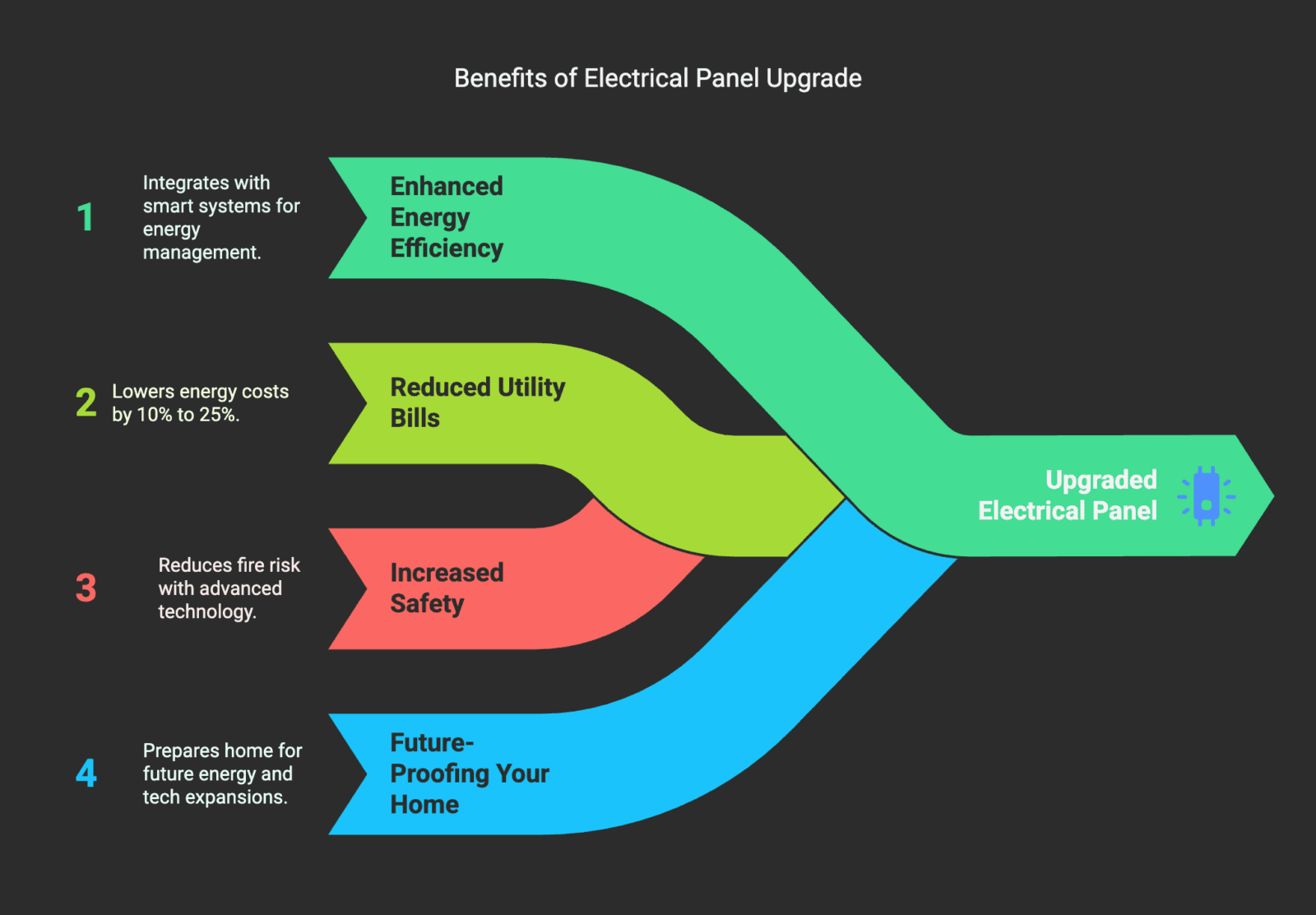
- Enhanced Energy Efficiency: Modern electrical panels integrate seamlessly with smart home systems, enabling real-time monitoring and improved energy management.
- Reduced Utility Bills: Efficient panels minimize electrical losses, ultimately lowering monthly energy costs. According to the U.S. Department of Energy, optimized home electrical systems can yield savings of 10% to 25% on electricity bills.
- Increased Safety: Up-to-date electrical panels reduce fire risk significantly by efficiently managing electrical loads and employing advanced breaker technology.
- Future-Proofing Your Home: Upgrading your panel prepares your home for future expansions, such as additional renewable energy systems, EV chargers, or more extensive smart home automation.
What This Blog Will Cover
This guide provides detailed insights into the following core areas:
- Understanding Home Electrical Phases
Clearly explain concepts like "what phase is normal American home power" and "split-phase home energy monitoring." - Technical Considerations for Upgrading:
- Essential technical criteria and electrical codes compliance.
- How to select the right capacity and features for your home.
- Step-by-Step Guide to Upgrading Your Electrical Panel:
- Essential steps, from initial inspection to installation.
- DIY vs. hiring professional electricians—pros and cons.
- Comparison of Different Electrical Panel Technologies:
- Smart electrical panels vs. traditional panels.
- Highlighting Grus.io's smart monitoring products and their advantages.
Through this guide, you’ll understand exactly why now is the right time to upgrade your home’s electrical infrastructure. You’ll also learn how Grus.io’s smart solutions, such as the WattPanel-2X split-phase electric monitor, can transform your home energy management, significantly reducing your energy bills and enhancing overall home safety.
Stay tuned as we dive deeper into the technology behind modern electrical panels, practical tips, and real-life case studies demonstrating substantial energy savings and enhanced safety.
🚀 Want to take control of your home energy costs?
🔹 Most U.S. homes use split-phase power (120/240V), but are you tracking your usage efficiently?
🔹 Without real-time monitoring, you could be wasting energy and money!✔ Grus Smart Meters provide:
✅ Real-time home energy tracking – Avoid high electricity bills.
✅ AI-powered efficiency insights – Automatically detect energy waste.
✅ Easy split-phase installation – No rewiring required.
Choosing the Perfect Electrical Panel for Your Home
Now that we've discussed why upgrading your home's electrical panel is a smart move, let's dive deeper into the fun part—how to select the perfect electrical panel for your cozy abode. Think of choosing an electrical panel like shopping for a smartphone: you wouldn't pick an outdated model when there's a sleek new device available with smarter features, right? Similarly, your electrical panel should fit seamlessly into your smart home's lifestyle.
Step 1: Understanding Your Power Needs
First things first—let's talk capacity. You might wonder: "What exactly is electrical panel capacity, and why does it matter?" Well, panel capacity refers to how much electricity your home's panel can safely handle. Here's a quick guide for typical household scenarios:
| Household Size | Recommended Panel Capacity | Common Usage Scenario |
|---|---|---|
| Small Home or Apartment | 100 amps | Basic appliances, lighting, HVAC |
| Average Family Home | 150-200 amps | EV charging, moderate appliance usage, solar setup |
| Large Home or Smart Home | 200-400 amps | Multiple EVs, advanced smart systems, large HVAC |
Not sure which category your home falls into? Don't worry—most American homes comfortably run on a 200-amp panel, providing ample room for modern appliances and future upgrades.
Step 2: Selecting Panel Features – Why Go Smart?
In the era of IoT (Internet of Things), upgrading your electrical panel isn't just about capacity—it's about intelligence. Today's smart electrical panels can monitor energy use, alert you to unusual power draws, and even automatically isolate problematic circuits to prevent damage.
Let’s look at some standout features you should consider:
| Feature | Traditional Panel | Smart Panel (e.g., Grus WattPanel-2X) |
|---|---|---|
| Real-Time Monitoring | ❌ | ✅ Real-time circuit-level insights |
| Energy Consumption Data | ❌ | ✅ AI-driven consumption analysis |
| Remote Control | ❌ | ✅ Mobile App control, anytime anywhere |
| Integration | ❌ | ✅ Compatible with smart home systems |
| Safety | Basic circuit breakers | Advanced overload and fault detection |
Now, isn't that an appealing upgrade? Your panel doesn't just manage electricity—it proactively enhances safety and efficiency!
Mermaid Visualization: How a Smart Electrical Panel Works
For our visual learners, here's a quick and easy-to-follow illustration of how a smart electrical panel like Grus WattPanel-2X integrates into your home setup:
graph TD; A["Home Electrical Input (240V Split-Phase)"] --> B["Smart Electrical Panel (Grus WattPanel-2X)"] B -->|"Real-time Monitoring"| C["Mobile App Dashboard"] B -->|"Automatic Fault Detection"| D["Safety Alert System"] B -->|"Energy Usage Data"| E["Cloud AI Analysis"] E -->|"Insights & Recommendations"| F["User Notifications"]
With a setup like this, your home practically manages itself—leaving you to relax and perhaps catch up on your favorite TV series, guilt-free!
Step 2: DIY vs. Professional Installation
Now, here’s a common question: "Can I upgrade the electrical panel myself?" Honestly, unless you're a licensed electrician, DIY isn't your friend here. While you can handle simpler home improvements, electrical work involves significant safety risks and must comply with local building codes.
Here’s a quick comparison to help you decide:
| Criteria | DIY Upgrade | Professional Installation |
|---|---|---|
| Cost | Lower upfront (potentially!) | Higher upfront but long-term savings |
| Safety Risk | High risk | Low—trained professionals |
| Warranty Coverage | Usually None | Warranty & insured work guaranteed |
| Code Compliance | Likely problematic | Fully compliant & certified |
| Time & Convenience | High effort | Hassle-free |
Trust me, opting for professional help ensures safety and peace of mind. Plus, you'll get a shiny certificate from the inspector instead of a fine!
Real-Life Example: Meet the Johnsons
Let's meet our friends—the Johnson family. Living in suburban California, the Johnsons decided to add an EV charger, solar panels, and upgraded their heating system with Grus EcoNet-HP thermostats. However, their 1980s electrical panel kept tripping, causing frustration and limiting their shiny new tech.
After a bit of research (and lots of coffee), they upgraded to the Grus WattPanel-2X. Immediately, the Johnsons noticed:
- Fewer Outages: No more spontaneous trips when charging the EV.
- Energy Savings: After six months, their electricity bill dropped by nearly 20% thanks to efficient monitoring and optimization insights.
- Peace of Mind: Automatic alerts keep them informed of their home’s electrical health, preventing unexpected issues.
Now the Johnsons enjoy worry-free, energy-efficient living. Sounds tempting, doesn't it?
What's Next?
Now you've grasped why and how to choose a smart electrical panel—great progress! In our final section, we'll walk through a detailed step-by-step upgrade process, explore cost-saving incentives, and look at exciting future trends in home electrical management.
But before we go there, how about a quick check on your own electrical setup?
🚀 Tired of unexpected power outages and high energy bills?
🔹 Most U.S. homes use split-phase power (120/240V), but are you truly tracking your energy efficiently?
🔹 Outdated panels can silently drain your wallet and compromise safety.✔ Grus Split-Phase Electric Monitor gives you:
✅ Instant insights into energy use – no surprises, no guesswork.
✅ AI-powered energy optimization – effortlessly save money.
✅ Simple installation – upgrade without disruption.👉 Discover the power of smarter home energy management today!
Step-by-Step Guide: How to Successfully Upgrade Your Home’s Electrical Panel
Congratulations! You've reached the exciting part of our journey—putting everything you've learned into action. Let's simplify the process of upgrading your electrical panel with an easy-to-follow, friendly guide. After all, with the right roadmap, even the most technical tasks feel less daunting. Let’s dive in!
Step 1: Conduct an Electrical Assessment
Before making any changes, it’s essential to know exactly where your current system stands. Schedule a home electrical assessment with a certified electrician. They'll check your home's wiring, current panel capacity, and evaluate your energy needs. Think of it as giving your home a thorough health check—it's preventive care for your electrical infrastructure!
Step 2: Choose Your New Electrical Panel
Based on the electrician's recommendations and your home's needs, pick the perfect panel. While traditional panels simply route electricity, smart electrical panels like the Grus WattPanel-2X add layers of intelligence, convenience, and savings. Imagine your panel not just working for you, but also communicating real-time updates directly to your phone!
Here's a quick recap of benefits when choosing a smart panel over a conventional one:
| Benefit | Traditional Panel | Grus WattPanel-2X |
|---|---|---|
| Real-time alerts | ❌ | ✅ |
| Remote monitoring | ❌ | ✅ |
| Smart home integration | ❌ | ✅ |
| AI-driven energy savings | ❌ | ✅ |
Step 3: Permits and Approvals
This step isn't the most exciting (paperwork rarely is!), but it's essential. Most electrical upgrades require local permits and compliance checks. Your electrician typically handles these, ensuring your home stays compliant with all local codes and safety regulations. Remember, doing it right means peace of mind and no headaches down the road.
Step 4: Professional Installation Day
Installation day—think of it as your home's big spa day! While it may involve temporary power interruptions, professional electricians will typically complete the panel upgrade within a few hours to a day. They'll:
- Disconnect power safely.
- Replace the old panel with your new smart panel.
- Reconnect and test circuits thoroughly.
- Restore power and confirm everything is running smoothly.
Don’t worry, your electricians will also clean up thoroughly afterward. It's a fuss-free process, leaving you free to relax (or binge your favorite series after power's restored)!
Step 5: Enjoy the Benefits and Monitor Your Energy Use
With your new electrical panel installed, now comes the fun part—watching your energy savings roll in! Use your Grus mobile app to monitor real-time energy consumption and spot patterns in your electricity usage. Set alerts for unusual spikes or opportunities to save even more. With a smart panel, saving energy becomes a game you'll love to win!
Financial Considerations: Costs and Incentives
Upgrading your electrical panel involves upfront costs but offers long-term financial rewards. A typical upgrade can cost between 1,000 to 3,500, depending on your home's specifics and regional labor rates. But here's the good news: local incentives and federal tax credits for smart energy management systems can significantly reduce this cost.
Potential Incentives & Savings:
- Federal and State Rebates: Up to 30% in federal tax credits if your upgrade supports renewable energy integration (e.g., solar panels or EV chargers).
- Utility Discounts: Some utility companies offer substantial rebates for installing energy-efficient upgrades.
- Energy Savings: Smart panel users typically report up to 20-25% lower electricity bills annually.
Sounds good, right? Financially, upgrading your electrical panel practically pays for itself.
Future Trends in Home Energy Management
Looking forward, upgrading your electrical panel isn't just about addressing current needs—it's about future-proofing your home. Here are exciting trends on the horizon:
- Increased EV Adoption: As more families switch to electric vehicles, upgraded electrical panels become a necessity.
- Smart Grid Integration: Future electrical panels will communicate seamlessly with the wider energy grid, optimizing energy usage automatically.
- Enhanced AI Capabilities: Imagine a future where your electrical panel learns your habits, predicts your energy needs, and suggests ways to reduce usage proactively.
Visualizing the trends, here's what the future smart home energy ecosystem might look like:
--- title: Smart Home & Grid Energy Flow --- graph TD; A["Smart Electrical Panel (Grus WattPanel-2X)"] -->|AI Optimization| B["Smart Grid Integration"] B -->|Energy Distribution| C["Community Renewable Energy"] A -->|Automated Management| D["EV Charging Stations"] A -->|Predictive Analytics| E["Home Appliance Automation"]
With smart panels at the center, your home's energy future looks bright—and exceptionally efficient!
Conclusion: Power Your Future with Smart Upgrades
Upgrading your electrical panel isn't just another home improvement task—it's a powerful step toward smarter living, improved safety, and significant savings. By making the leap now, you're not only enhancing your home's efficiency today but also preparing it for an exciting, tech-driven future.
Ready to make your home smarter, safer, and more efficient? The Grus WattPanel-2X is your ideal partner for turning those energy-efficiency dreams into reality.
🚀 Are unexpected outages and high energy bills keeping you up at night?
🔹 Most U.S. homes use split-phase power (120/240V), but are you truly tracking your energy efficiently?
🔹 Old electrical panels silently drain your wallet and compromise your safety.✔ Grus Split-Phase Electric Monitor gives you: ✅ Instant insights into your energy use – no more guesswork.
✅ AI-powered energy savings – save effortlessly.
✅ Simple, disruption-free installation – quickly upgrade your home.

